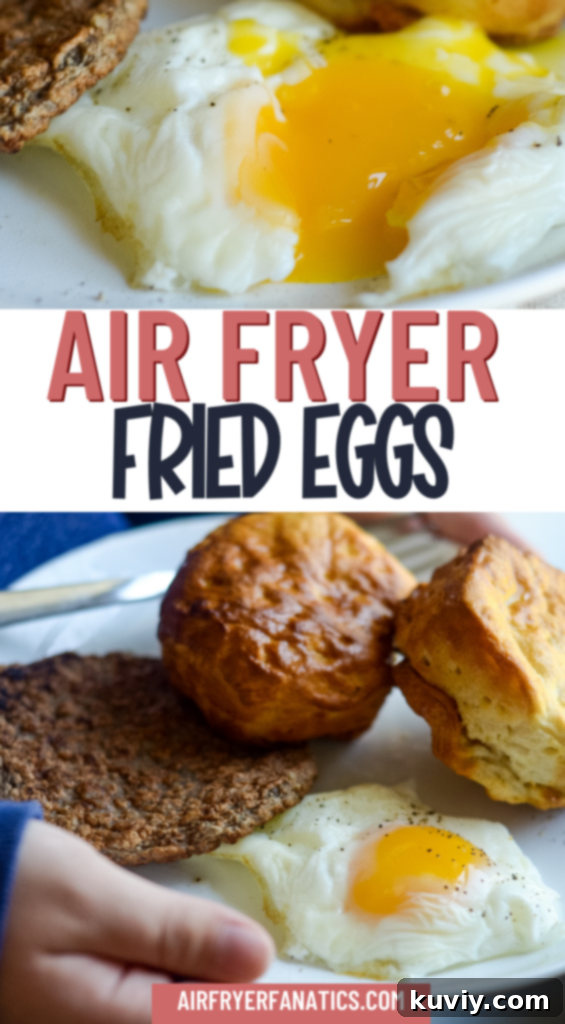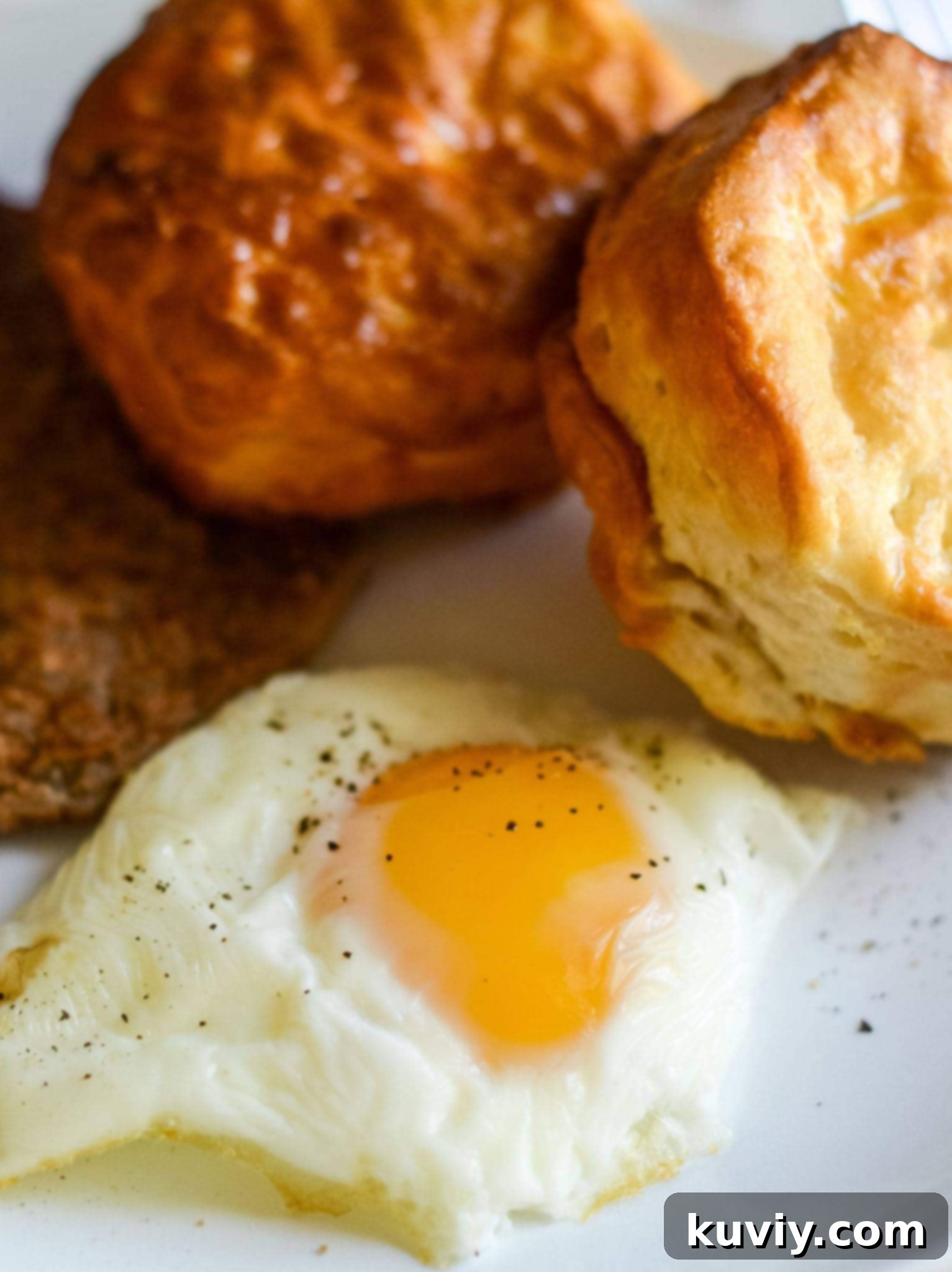How to Make Perfect Air Fryer Eggs: Your Ultimate Guide to Easy Breakfasts
Discover the simplest and most efficient way to cook eggs exactly to your liking with this incredible air fryer method. Forget the hassle of boiling water or constantly monitoring a frying pan – air-fried eggs deliver consistent results every single time, whether you prefer a runny yolk, a jammy center, or a firm, fully cooked egg. This quick and easy recipe is perfect for busy mornings, healthy meal prep, or simply adding a versatile protein to any meal. You’ll be amazed at how effortlessly you can achieve perfectly cooked eggs without any fuss or mess, transforming your breakfast routine in just minutes.
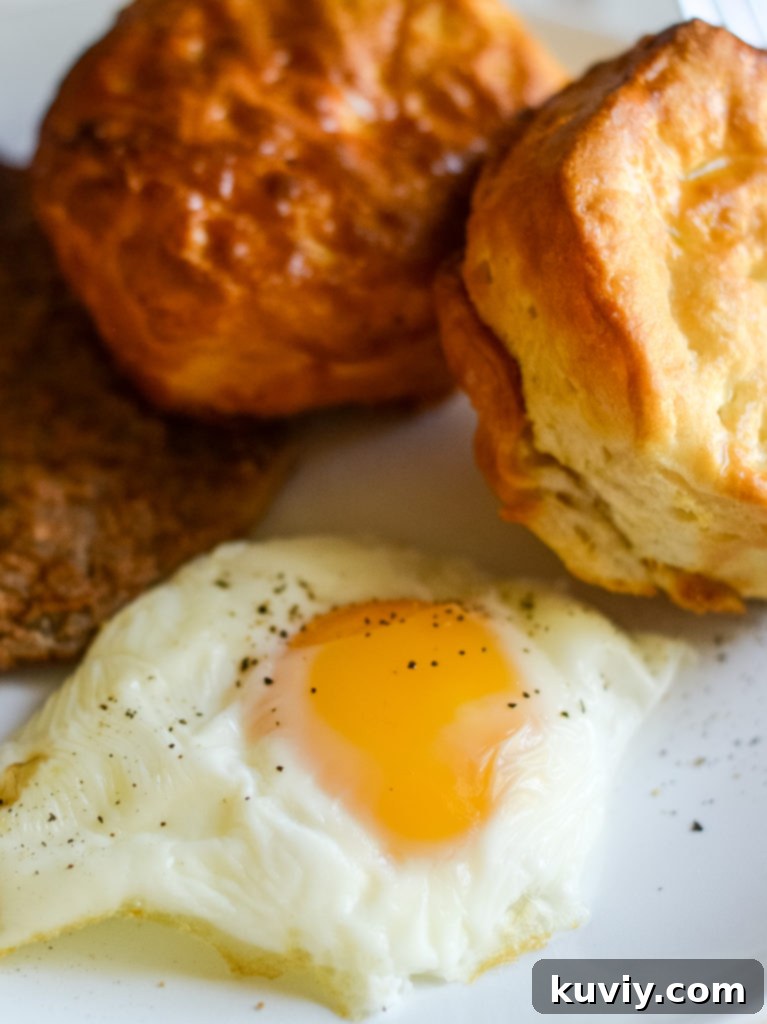
Why Air Fryer Eggs Are a Breakfast Game Changer
The air fryer has revolutionized kitchen cooking, and eggs are no exception. This method offers several distinct advantages over traditional cooking techniques, making it a true breakfast game-changer. Firstly, it’s incredibly convenient; you can cook one egg or several at once, tailored precisely to your family’s preferences. The air fryer circulates hot air evenly, ensuring that your eggs cook uniformly without hot spots or undercooked patches, a common issue with stovetop methods. This hands-off approach frees up your time to prepare other elements of your breakfast or simply relax.
Beyond convenience, air frying eggs significantly reduces cleanup. When using ramekins or silicone molds, the mess is minimal compared to scrubbing a greasy frying pan. Plus, you’re not dealing with a pot of boiling water, eliminating the risk of cracked shells or messy peeling often associated with traditional hard-boiled eggs. This consistency is invaluable for busy cooks and anyone looking for reliable results. It’s a cleaner, quicker, and more reliable way to prepare this breakfast staple, making it an ideal solution for anyone seeking efficiency without compromising on taste or texture. You can even cook biscuits and sausage alongside your eggs in many air fryer models, creating a complete breakfast with minimal effort.
Essential Ingredients & Equipment for Air Fryer Eggs
Making delicious air-fried eggs requires minimal ingredients and simple kitchen tools. Here’s what you’ll need to get started on your journey to perfect air fryer eggs:
- Whole Eggs: Fresh, large eggs are generally recommended for consistent results. You can use any size, but cooking times may vary slightly.
- Container Options: You’ll need a heat-safe vessel to hold your eggs. Choose from the following, depending on what you have available and your preferred egg shape:
- Aluminum Foil: Easily shaped into a small pouch or cup, ideal if you don’t have other options. It’s flexible and readily available.
- Ramekins: Small ceramic or glass dishes (around 4 oz is common) that are oven-safe and fit well in most air fryers. These provide a beautifully round, uniform egg shape.
- Silicone Molds or Silicone Cupcake Liners: Excellent for non-stick cooking and extremely easy egg removal, these often come in cupcake or egg bite shapes, offering convenience and consistent results.
- Cooking Spray: An essential for preventing sticking. Opt for:
- Grapeseed Oil Cooking Spray: Highly recommended due to its exceptionally high smoke point, which is crucial for air frying at the typically higher temperatures (like 390°F / 199°C). This helps avoid smoking and unwanted flavors.
- Olive Oil Cooking Spray: Can be used, but note its lower smoke point compared to grapeseed oil. It might smoke slightly more at higher temperatures, so monitor closely.
Having these simple items on hand ensures a smooth and successful air frying experience. The choice of container is largely a matter of personal preference and what you have available, as all options yield delicious results with a perfectly cooked interior.
Air-Fried Eggs: Step-by-Step Recipe Instructions
Achieving perfect air-fried eggs is incredibly straightforward and takes just a few minutes. Follow these simple steps for a delicious and hassle-free breakfast or snack:
- Prepare Your Container: For each egg you plan to cook, prepare a heat-safe container. If using aluminum foil, tear off a square sheet and mold it into a small cup or pouch that will comfortably hold an egg and fit into your air fryer basket. For ramekins or silicone molds, simply ensure they are clean and ready for use.
- Generously Grease: This step is crucial for non-stick results! Lightly and evenly coat the inside of your chosen container (foil pouch, ramekin, or silicone mold) with a good quality cooking spray, such as grapeseed oil. A thorough coating ensures the cooked egg slides out effortlessly and minimizes cleanup.
- Crack and Place: Carefully crack one whole egg into each prepared and greased container. Be gentle to avoid breaking the yolk, especially if you’re aiming for a soft-set or medium-set egg.
- Load the Air Fryer: Carefully place the filled containers into your air fryer basket. Arrange them in a single layer, ensuring there’s enough space around each container for proper hot air circulation. This is key to achieving even cooking and consistent results across all eggs. Avoid overcrowding the basket, as this can impede airflow and lead to unevenly cooked eggs.
- Air Fry to Perfection: Close the air fryer basket and cook the eggs at 390°F (199°C). The cooking time will vary based on your desired doneness and the specific model of your air fryer.
- For a soft yolk with set whites: start with 6-8 minutes.
- For medium-set eggs with a slightly jammy, creamy yolk: aim for 8-10 minutes.
- For hard-set eggs with a firm, fully cooked yolk: cook for 10-12 minutes.
For a beautifully set egg with a slightly jammy yolk, 6 minutes at 390°F often yields perfect results in our air fryer. Always check for doneness towards the end of the cooking time, as air fryers can vary significantly in their actual temperature and cooking efficiency.
- Carefully Remove and Serve: Once cooked to your preference, carefully remove the hot containers from the air fryer using tongs or oven mitts. Let them cool for a moment before gently sliding the eggs onto your plate. Serve immediately, seasoned to taste, and enjoy with your favorite accompaniments!
For the full printable recipe card with detailed measurements and nutritional information, please scroll to the bottom of this post. It’s an easy way to keep track of this simple air fryer egg recipe.
Choosing Your Container: Foil, Ramekins, or Silicone Molds?
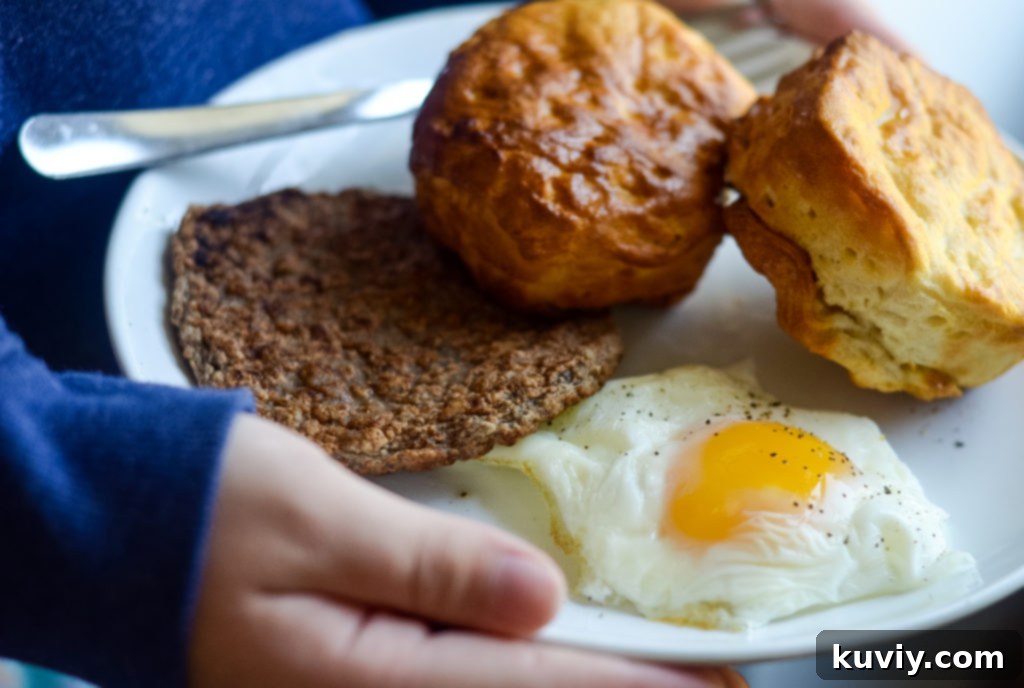
One of the most common questions when making eggs in the air fryer revolves around the best container to use. Thankfully, you have several excellent options, each with its own benefits. The primary requirements are that the vessel is heat-safe for air fryer temperatures and allows for proper air circulation around it within the air fryer basket.
Aluminum Foil: When we first started experimenting with air-fried eggs, aluminum foil was our go-to. It’s incredibly versatile and readily available in most kitchens. You can easily form small foil packets or cups that securely hold the egg. The main advantage of foil is its flexibility; you can shape it to fit almost any air fryer model and create custom sizes for your eggs. While effective, it sometimes results in a less uniform egg shape compared to rigid molds, and you’ll need to use a new piece for each batch.
Ramekins: Over time, many air fryer enthusiasts, including us, have discovered the superior results offered by small ceramic ramekins (typically 4 oz). These produce beautifully round, perfectly shaped eggs, akin to a traditional fried egg but without the stovetop mess. Ramekins are durable, reusable, and distribute heat very evenly, contributing to consistent cooking. They are a fantastic investment if you plan to make air fryer eggs regularly and appreciate a neat presentation.
Silicone Molds/Cupcake Liners: Another fantastic and increasingly popular option is using silicone cupcake liners or specialized silicone egg bite molds. Silicone is naturally non-stick, making egg removal incredibly easy and cleanup a breeze – often just a quick rinse is all that’s needed. These molds also create well-defined egg shapes and are durable for repeated use, making them an eco-friendly choice. Always ensure your silicone molds are rated as oven-safe and can withstand the temperatures used in an air fryer.
Ultimately, the best choice depends on your personal preference, what you have readily available in your kitchen, and your desired egg shape. All three methods will yield wonderfully cooked air-fried eggs. Experiment with each to see which one works best for your cooking style and desired outcome; you might find yourself switching between them for different purposes.
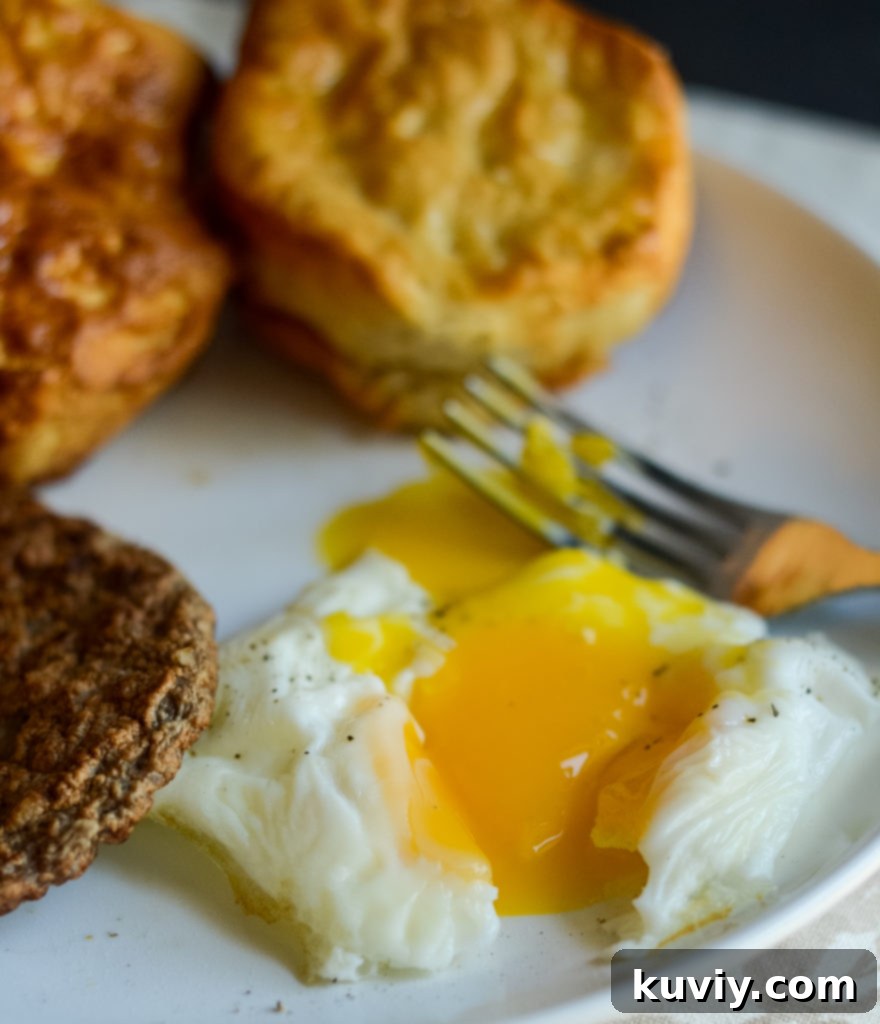
Pro Tips for Making Perfect Air Fried Eggs Every Time
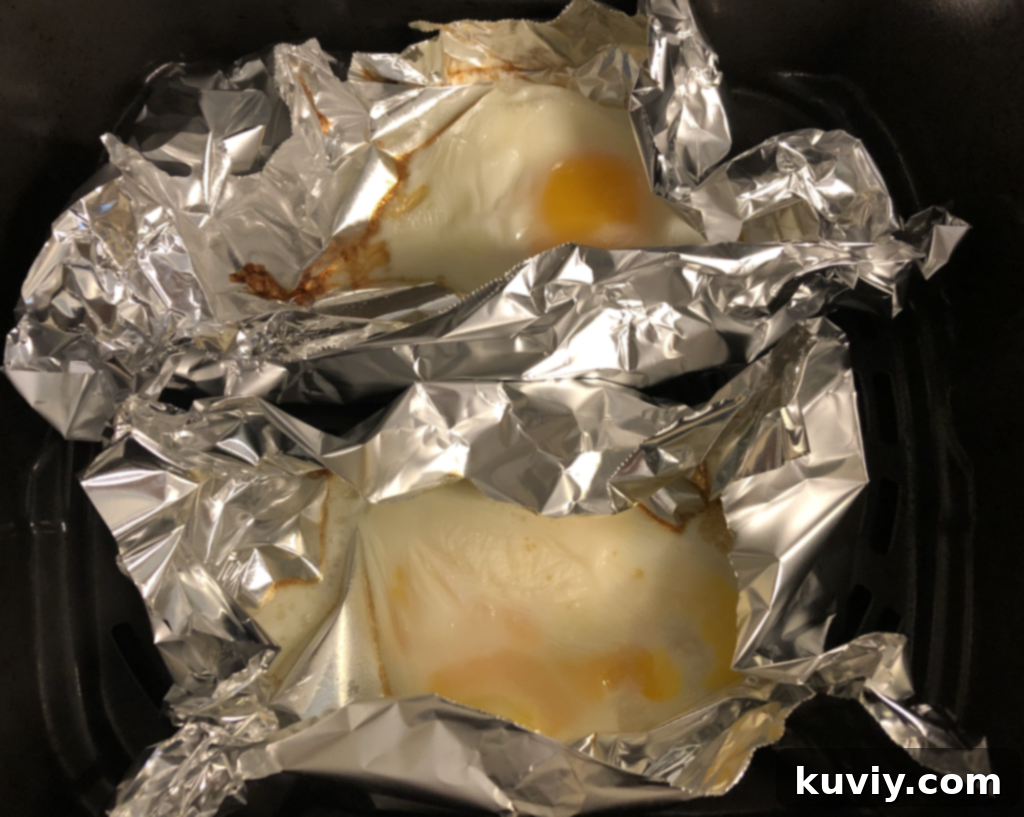
- Monitor Your Air Fryer: Air fryers can vary significantly in actual temperature and cooking efficiency. The first time you make air-fried eggs, it’s crucial to closely monitor the cooking time. While 390°F (199°C) for 6 minutes is a good starting point for a soft-medium egg, your specific machine might require a minute more or less to reach your desired consistency. Keep an eye on them, especially during the last few minutes, and adjust accordingly for future batches. Make note of your preferred time for consistent results.
- Choose the Right Container for Shape: For the most aesthetically pleasing and perfectly shaped eggs, particularly round ones, we highly recommend using silicone molds or ramekins. These provide a much cleaner and more uniform shape than foil. If these aren’t available, aluminum foil pouches will still work effectively, though the shape might be less uniform.
- Don’t Forget to Spray: Always spray your foil, ramekin, or silicone mold generously with cooking oil spray (preferably grapeseed oil) before cracking in the egg. This is vital for preventing sticking and ensures easy removal and quick cleanup. Even with non-stick silicone, a light spray can make a big difference.
- Consider Preheating: While not strictly necessary for all air fryers or egg consistencies, preheating your air fryer for 3-5 minutes can help achieve more consistent results, especially for quicker cooking times like soft-boiled eggs, ensuring the temperature is stable from the start.
- Avoid Overcrowding the Basket: Ensure you leave enough space between your egg containers in the air fryer basket. Proper air circulation is absolutely essential for even cooking. Overcrowding can lead to unevenly cooked eggs, with some being overdone and others undercooked.
- Get Creative with Add-ins: Air-fried eggs are a blank canvas for flavor. Enhance your breakfast or snack by adding fresh herbs like chopped chives, parsley, or dill; a sprinkle of your favorite cheese (cheddar, feta, or mozzarella work wonderfully); or a dollop of fresh salsa directly into the egg container before cooking. These additions cook along with the egg, infusing it with delicious flavors.
Air Fryer Egg Cooking Times for Every Preference
One of the best features of cooking eggs in the air fryer is the ability to precisely control the yolk’s consistency. This allows you to tailor your eggs exactly to your liking, whether you prefer them perfectly runny or completely firm. Here’s a general guide for cooking times at 390°F (199°C), though remember to adjust based on your specific air fryer model and the size of your eggs:
- Soft Eggs with a Runny Yolk (6-8 Minutes): For a delicate, liquid yolk perfect for dipping toast, crusty bread, or even asparagus, aim for this shorter cooking window. The egg whites will be fully set but remain wonderfully tender.
- Medium Eggs with a Jammy Yolk (8-10 Minutes): If you prefer a slightly set, jammy yolk that’s still soft and creamy in the center, this is your sweet spot. This consistency is incredibly versatile and a popular choice for salads, breakfast sandwiches, or enjoyed on its own.
- Hard-Set Eggs (Fully Cooked Yolk) (10-12 Minutes): For a firm, fully cooked yolk, ideal for chopping into egg salad, adding to a protein plate, or simply enjoying as a grab-and-go snack, cook for this longer duration. For a truly hard-boiled-like consistency, you can even achieve perfectly peelable hard-boiled eggs in the air fryer without water, which is a fantastic method to explore if you want a larger batch of hard eggs!
These air-fried eggs are set to become your new favorite method for preparing this versatile ingredient. They’re not only perfect for a quick and satisfying meal any time of day but also excellent for weekly meal prep, providing a healthy and convenient protein source for days to come. Experiment with these timings to find your perfect egg!
The Importance of Cooking Oil Spray for Non-Stick Results
Using the correct cooking oil spray is paramount to ensure your air-fried eggs don’t stick to their containers, whether you’re using foil, ramekins, or silicone molds. This simple yet critical step saves you from frustration and tedious cleanup after enjoying your meal. It’s essential to spray the inside of your chosen container generously and evenly between each cooking session, especially if you’re making multiple batches of eggs.
A good coating of oil creates a vital non-stick barrier, allowing the perfectly cooked egg to slide out effortlessly onto your plate. While olive oil cooking spray is a common household item and can certainly work, it has a relatively low smoke point. This means at higher air fryer temperatures (like the 390°F recommended for eggs), it might start to smoke slightly or develop a slightly burnt flavor, which can impact the taste of your delicate eggs. For optimal results and to avoid any smoke or unwanted tastes, it’s best to use a cooking oil with a higher smoke point. Grapeseed oil cooking spray is an excellent choice, as are avocado oil or canola oil sprays. These higher smoke point oils ensure your eggs cook perfectly without any issues, making the entire process smooth, enjoyable, and mess-free.
Creative Ways to Serve Your Air Fried Eggs
Air-fried eggs are incredibly versatile and can be incorporated into countless meals beyond just a simple breakfast. Their perfect consistency and rich flavor make them an excellent addition to a variety of dishes, elevating both taste and nutritional value. Here are some inspiring ideas to enhance your culinary creations:
- Classic Breakfast Pairings: Naturally, air-fried eggs pair wonderfully with traditional breakfast staples. Enjoy them alongside crispy Air Fryer Bacon, fluffy pancakes, or sweet Air Fryer Cinnamon Rolls. Don’t forget a side of savory sausage for a complete, quick, and satisfying air fryer breakfast!
- Elevated Avocado Toast: Transform your everyday avocado toast by placing a perfectly air-fried egg on top. The runny or jammy yolk adds a rich, luxurious creaminess that’s simply irresistible, creating a gourmet breakfast or brunch in minutes.
- Healthy & Hearty Salads: A medium or hard-set air-fried egg is a fantastic protein boost for any salad. Slice it up and add it to a vibrant Cobb salad, a classic Caesar salad, or a simple green salad for a satisfying and nutritious lunch that keeps you full longer.
- Quick Breakfast Sandwiches & Burritos: Use your air-fried egg as the star of a quick breakfast sandwich on an English muffin, bagel, or a croissant. Alternatively, wrap it in a tortilla with cheese, beans, and your favorite veggies for a delicious breakfast burrito.
- Homemade Egg Salad: For hard-set eggs, chop them up and mix with mayonnaise, Dijon mustard, finely diced celery, and your preferred seasonings for a classic egg salad that’s perfect for sandwiches, crackers, or lettuce wraps.
- Simple Seasoning & Garnishes: Sometimes, less is more. A simple sprinkle of sea salt, freshly ground black pepper, a dash of your favorite hot sauce, or a spoonful of fresh salsa is all you need to truly enjoy the pure, rich flavor of your perfectly cooked air-fried egg.
- Versatile Side for Main Meals: Don’t limit eggs to breakfast! Air-fried eggs can complement dinner too. Serve them alongside a plate of roasted vegetables, grilled chicken, a simple stir-fry, or even a bowl of rice for an added layer of flavor and protein, making weeknight meals more exciting.
To further expand your air frying horizons and discover even more innovative ways to prepare eggs, explore all the amazing methods to make eggs in the air fryer in this comprehensive post!
Storing and Reheating Air Fryer Eggs
Air-fried eggs are not only delicious fresh but also excellent for meal prepping. If you find yourself with leftovers or intentionally cook extra for later in the week, proper storage is key to maintaining their freshness, flavor, and texture.
First and foremost, allow the cooked eggs to cool completely to room temperature before storing them. This crucial step prevents condensation from building up inside the container, which can lead to soggy textures and a less enjoyable eating experience. Once thoroughly cooled, transfer the eggs to an airtight container. Place the container in the refrigerator, where the eggs will stay fresh for up to 3 days. This makes them perfect for grabbing a quick, protein-packed breakfast, adding to a lunch salad, or incorporating into various dishes throughout your busy week.
When you’re ready to reheat your air-fried eggs, the microwave is your best friend for convenience and speed. Simply place the eggs on a microwave-safe plate and heat them for about 30 seconds, or until they are warmed through to your liking. Be careful not to overheat, as this can make the yolks rubbery and less appealing. With these simple storage and reheating tips, you can enjoy your perfectly cooked air-fried eggs long after they’re initially made, providing a convenient and healthy option on demand.
Mastering the art of making perfect eggs has never been easier than with these air-fried eggs. They consistently cook to perfection, offering a mess-free, stove-top-free solution for any meal. Imagine cooking your eggs right alongside sausage or biscuits, all in one go, for a complete and effortless breakfast! This method truly transforms egg preparation, making it a joy rather than a chore and a staple in your air fryer recipe collection.
More Air Fryer Egg Recipes You’ll Love:
-
Air Fried Hard Boiled Eggs (Easy to Peel!)
-
Air Fryer Eggs in Silicone Cups
-
Air Fryer Eggs in a Basket
-
Easy Air Fryer Scrambled Eggs

Air Fried Eggs Recipe
Air Fryer Fanatics
Pin Recipe
Save RecipeSaved!
Ingredients
- 2 Large Eggs
- Aluminum Foil, Ramekins, or Silicone Molds for cooking (see notes for details)
- Grapeseed Oil Cooking Spray or other high smoke point oil spray
Instructions
-
Prepare a container for each egg: either make a foil pouch, or use a ramekin or silicone mold that fits in your air fryer basket.
-
Lightly coat the inside of the container with grapeseed oil spray (or preferred high smoke point oil spray) to prevent sticking.
-
Carefully crack one egg into each prepared container.
-
Place the filled containers in the air fryer basket, ensuring good air circulation around each. Cook at 390°F (199°C) for your desired doneness: 6-8 minutes for soft yolk, 8-10 minutes for medium yolk, or 10-12 minutes for hard-set yolk.
-
Carefully remove the hot containers from the air fryer using tongs or oven mitts, and serve the air-fried eggs immediately with your favorite sides.
Notes
Container Choices: If you prefer not to use foil, 4oz ramekins work exceptionally well for perfectly round eggs and offer easy cleanup. Any oven-safe dish or bakeware that securely fits within your air fryer basket can be used. For a convenient and reusable non-stick option, we regularly use these Silicone Cupcake Molds to make this recipe.
Optimal Oil Choice: Grapeseed oil spray is strongly recommended for this recipe due to its high smoke point, which helps prevent smoking and avoids imparting any off-flavors to your eggs at the required higher cooking temperatures. Avocado oil or canola oil sprays are also excellent alternatives that perform well in the air fryer.
Nutrition
